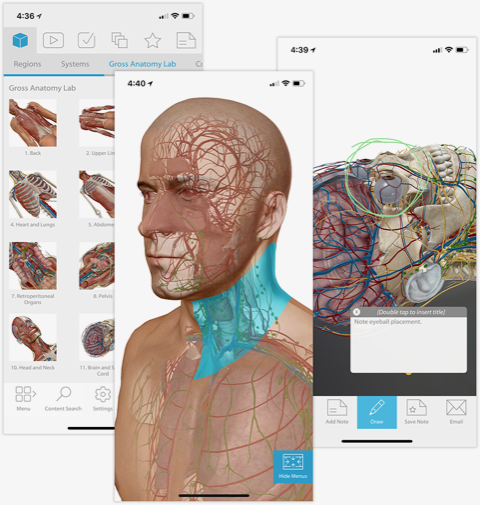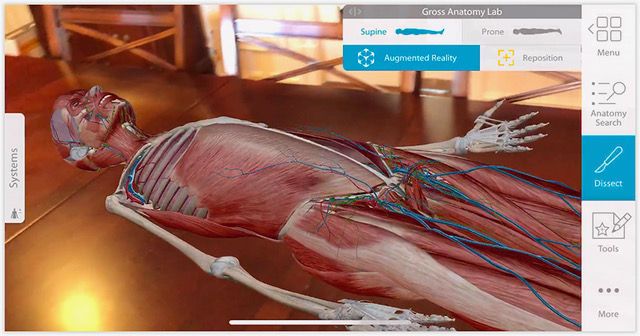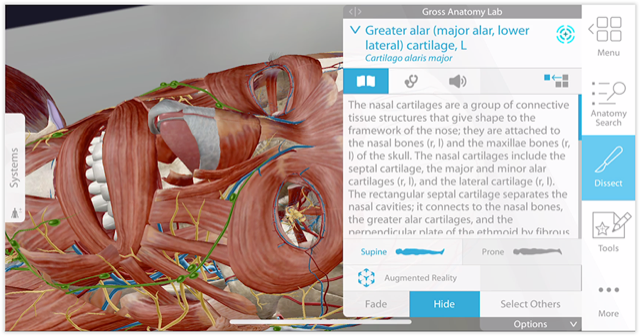Welcome to Pogue’s Rated:App series. Each week, I’ll install whatever is the No. 1 bestselling app on the iOS or Android store and review it, to save you the effort in case it’s a turkey!
This week, the No. 1 bestselling app on the iPhone app store, and the No. 2 app on the Google Play store, is Human Anatomy Atlas 2018.
Like most apps that hit No. 1, HAA is all about visuals; it gives you an interactive, incredibly detailed, medically accurate jaw-dropping 3-D view of the human body.
But unlike most apps that hit No. 1, I know why this app (which has been around for years) suddenly zoomed to the top of the list: Its usual price is $25, but it went on “super sale” this week for $1. (They haven’t decided when the sale will end.)
Human Anatomy Atlas 2018 is a gigantic, pretty complex app. It’ll eat up 1 gigabyte of space on your phone, and take you some time to learn. Neither of those points would be an obstacle to the app’s target audience: med students and health care pros.
But at $1, this app is suddenly attractive to a much broader range of people. It’s pretty stunning.


Human Anatomy Atlas 2018 puts a colorful, non-smelly digital cadaver on your phone.
What it does
There are, as you may be aware, a number of different parts of the human body, so HAA 2018 offers several tabs that let you control how to begin your exploration:
- Regions. Head/neck, abdomen, pelvis, knee, etc.
- Systems. Skeleton, circulatory, nervous, respiratory, muscular, digestive, reproductive, etc.
- Gross Anatomy Lab. By “gross,” they don’t mean “disgusting” here; they mean “general,” as in “general anatomy.” Here, the app presents a digital corpse lying before you; you can turn it, flip it, or zoom into it.
- Cross sections. Here, you get slices (they look like MRI scans) — of the head, thorax, abdomen, or pelvis, from various angles.
- Microanatomy. This tab offers close-up views of individual structures like the eyeball, tongue, and hair follicles.
- Augmented reality. Here’s the best part, newly added to the Android version of the app (and already part of the iOS version): You can place your virtual corpse onto an actual table (or floor, or desk, or bed) in front of you, and walk around it, using your phone as a viewer. You can even push the phone inside the body, flying through it. It’s freaky and beautifully done and absolutely astonishing — and unbelievably useful, I’d think, to med students.


You really have to see the augmented-reality feature (in the video above, for example) to believe it.
In all of these views, you can tap a body part to dissect it, peeling away layers to see what’s underneath. It’s the cleanest, clearest, least stinky way to take apart a cadaver.
You can also tap a body part to read all about it, or hear its name pronounced.


Tap any structure to read about it, hear its name pronounced, or designate it a favorite part of the body.
There are also 128 quizzes, a testament to the app’s academic purposes. For example, you’re shown an illustration of the leg and asked to tap “the fifth metatarsal.”
Also on tap: Short videos (showing how muscles, joints, cells, organs, systems, and diseases work). Note, though, that you get only one or two examples in each of these video categories; you’re supposed to pay $20 to unlock the rest.


The videos are short, clear, and narrated.
You can also create 3D fly-through tours of your favorite body parts, or create a library of favorite bits, or annotate certain views by drawing on them (with a fairly feeble pen tool — no choice of thickness or color) or typing notes. You can also search for a certain anatomical feature, get help, or choose a different language (seven are available).
We’re talking ridiculously complete.
Get it?
The company behind this app, Visible Body, has been toiling away in Boston for 15 years, refining and refining its medically accurate illustrations of the human body. You may run across their stuff as part of free online classes, in special corporate software for companies like Johnson & Johnson or Medtronic, in textbooks from Pearson or McGraw Hill, and so on.


In Dissect mode, each time you tap a layer, it disappears.
If the app were still $25, I’d tell you that Human Anatomy Atlas is a great learning tool — if anatomy is part of your career.
But at $1, there’s enough magic in this app to recommend it to anyone. Like the human body itself, it’s sometimes icky, often mind-blowing, and always amazing in that it works so well.
David Pogue, tech columnist for Yahoo Finance, welcomes non-toxic comments in the Comments below. On the Web, he’s davidpogue.com. On Twitter, he’s @pogue. On email, he’s poguester@yahoo.com. You can sign up to get his stuff by email, here.
Read more
Pogue reviews this week’s No. 1 most downloaded app: Sky Guide AR
The controversial Vero is this week’s David Pogue’s Rated:App
Bitmoji is this week’s David Pogue’s Rated:App
This week’s David Pogue’s Rated:App is on Facetune
Website: LINK
Schreibe einen Kommentar
Du musst angemeldet sein, um einen Kommentar abzugeben.